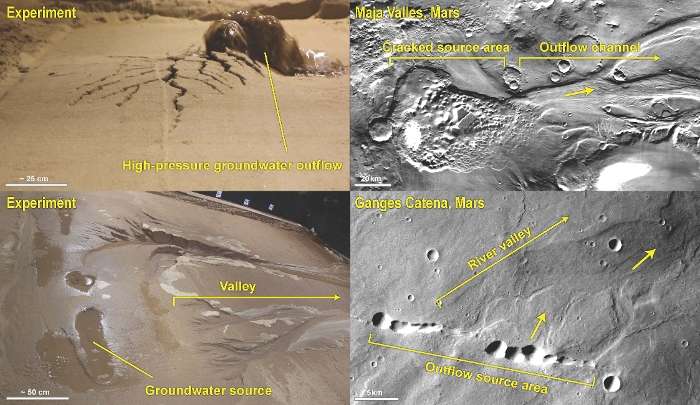In its early years, planet Mars comprised large volumes of groundwater, which regularly flowed to the surface. This is the conclusion reached by Utrecht University's PhD candidate Wouter Marra following observations and scale experiments. Regardless of the climate, the water in the ground was liquid and was, for a long time, the main source of water on Mars. Marra will defend his PhD thesis from the User Support Programme Space Research on 22 May.
Various traces of past processes, including volcanism and the presence of water, are still visible on the surface of Mars. There is substantial evidence to suggest that water was once present on Mars. The key question, therefore, is where that water came from. Wouter Marra's PhD research shows that many of the traces implying a water cycle were actually formed by groundwater that, for various reasons, came up to the surface.
Virtually no liquid water
'For the largest part of Mars' history, liquid water could not exist at the surface' says Marra. 'The atmospheric pressure was so low that any liquid water would quickly have frozen or evaporated. But many structures, such as channels and valleys, can be seen on the surface of Mars, and these suggest that flowing water did exist. My theory was that the liquid water that created these structures came from beneath the surface, where water was present in liquid form. As no or hardly any of these types of systems exist on Earth, I conducted scale experiments to find out more how such systems work.'
Scale experiments
Groundwater seepage can come from various sources, either close-by or far away, and pressurised or unpressurised. These various influences create different landscape patterns. To discover the effect of the source location, Marra built an experimental set-up consisting of a sediment layer through which groundwater could flow up to the surface from various sources. As he explains, 'I focused on the formation of the entire landscape. I can link patterns that developed in my experiments to specific water sources. Some patterns in several areas on Mars really resemble my experimental results.'
Water pressure is key
The outflowing groundwater pressure plays a key role in the formation of landscapes. 'In my experiments I observed different landscapes resulting from different groundwater pressure,' says Marra. 'Some of the most enigmatic landscapes on Mars can now be explained by brief but large eruptions of subsurface lakes, like volcanoes but with water. Furthermore, I found plenty of evidence for smaller and less extreme cases of groundwater outflow which allowed me to reconstruct the former hydrology of Mars.
Marra's reconstruction of Mars' history shows that groundwater must have been present on Mars for a long time, and maybe still is. This groundwater repeatedly flowed up to the surface, albeit very sporadically and in ever-decreasing volumes.
Pressurized Groundwater Eruption Experiment
Early history
The areas in which these traces have been observed are over three billion years old. Marra's research consequently constitutes new evidence of the presence of groundwater in the history of Mars. The times when groundwater was the main source of water on the surface of Mars do not necessarily coincide with an optimal climate, with high atmospheric pressures and temperatures. He concludes: 'On the contrary, the presence of groundwater as a main source of water can easily be explained by a cold climate in which there is hardly any liquid water on Mars.'
























